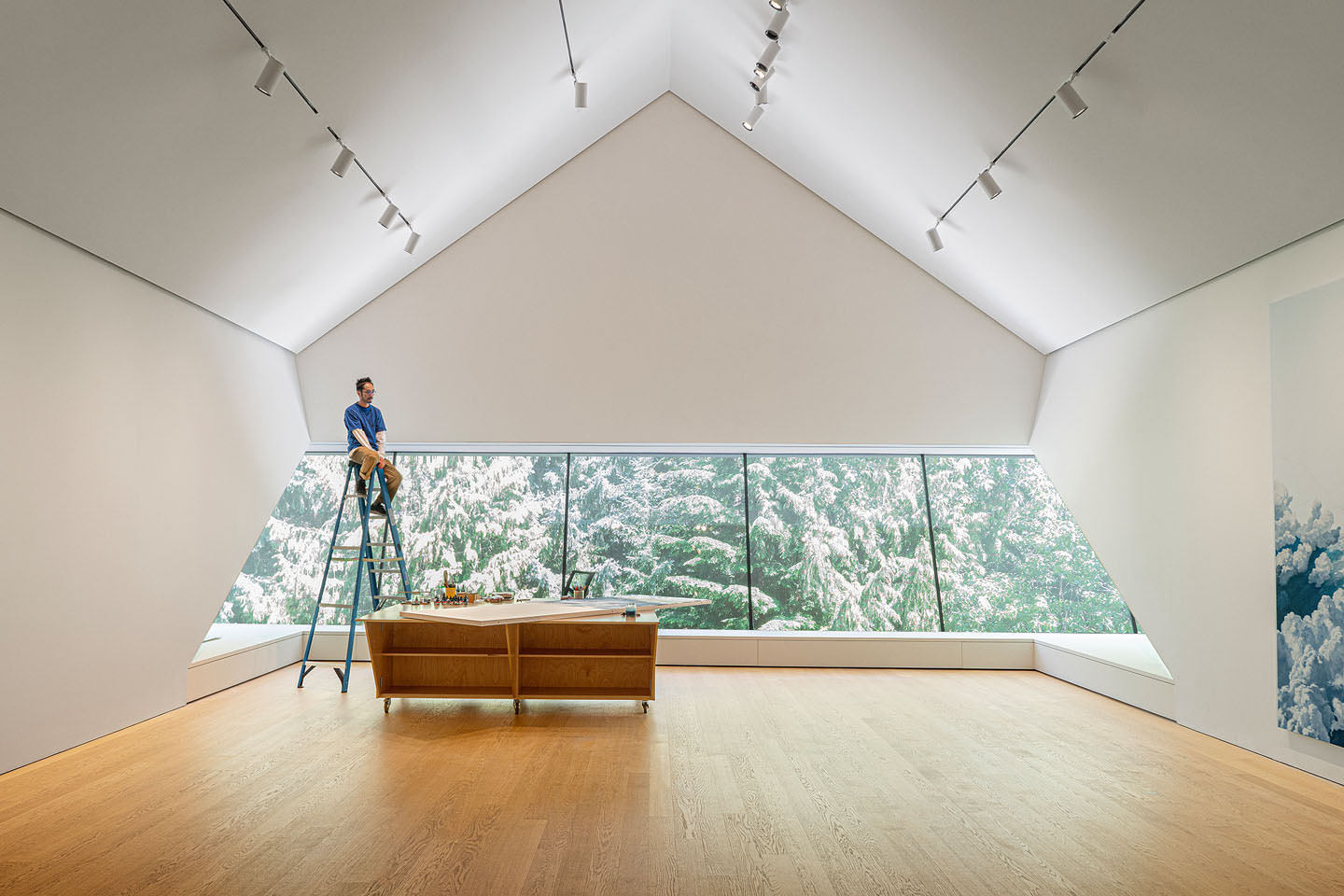Manabu Ikeda perches on a tall stepladder and checks his work. The Japanese artist spends up to eight hours a day drawing, bent over his flat canvas, the ladder offering a necessary wider perspective to the intensely detailed miniature scenes-within-scenes he creates. The piece underway is massive, a series of six one-by-three-metre panels, the bottom thirds of which show a burgeoning, swirling body of water. Begun in 2019, there are, Ikeda says, at least two more years of work left. Once it is finished, the panels will be filled with details created from millions of tiny pen lines.
“I have no idea,” Ikeda says with a shrug when I ask what the mass of white will become. “Probably ocean or cloud. No white.”
We are talking in the upstairs studio of Whistler’s Audain Art Museum, a light-filled airy space with an expansive picture window looking out onto a sea of fir trees. Downstairs is Ikeda’s first solo retrospective in North America, “Flowers from the Wreckage,” where the scale and ambition of his work has been admirably matched by curator Kiriko Watanabe, who presents the first international show organized in-house by the Audain.
This is unapologetic maximalism, where there is no such thing as too much.
The discipline of the artist is evident in his work: bold central motifs—a giant wave, a tree, a ship, an island—reveal multitudinous themes and details. From a few feet back, the image has immediate impact; close up, it’s another story. Endless stories, in fact. This is unapologetic maximalism, where there is no such thing as too much. Overwhelming in scope, it demands attention and patience, the layers upon layers peeled back. The tension between the traditional method Ikeda employs (fine pen and ink) and the very contemporary work, at ease with popular cultural mores of meta- and multiverses, is startling. These drawings are at once fantastical and firmly rooted in 21st-century realities of climate chaos and natural disasters.
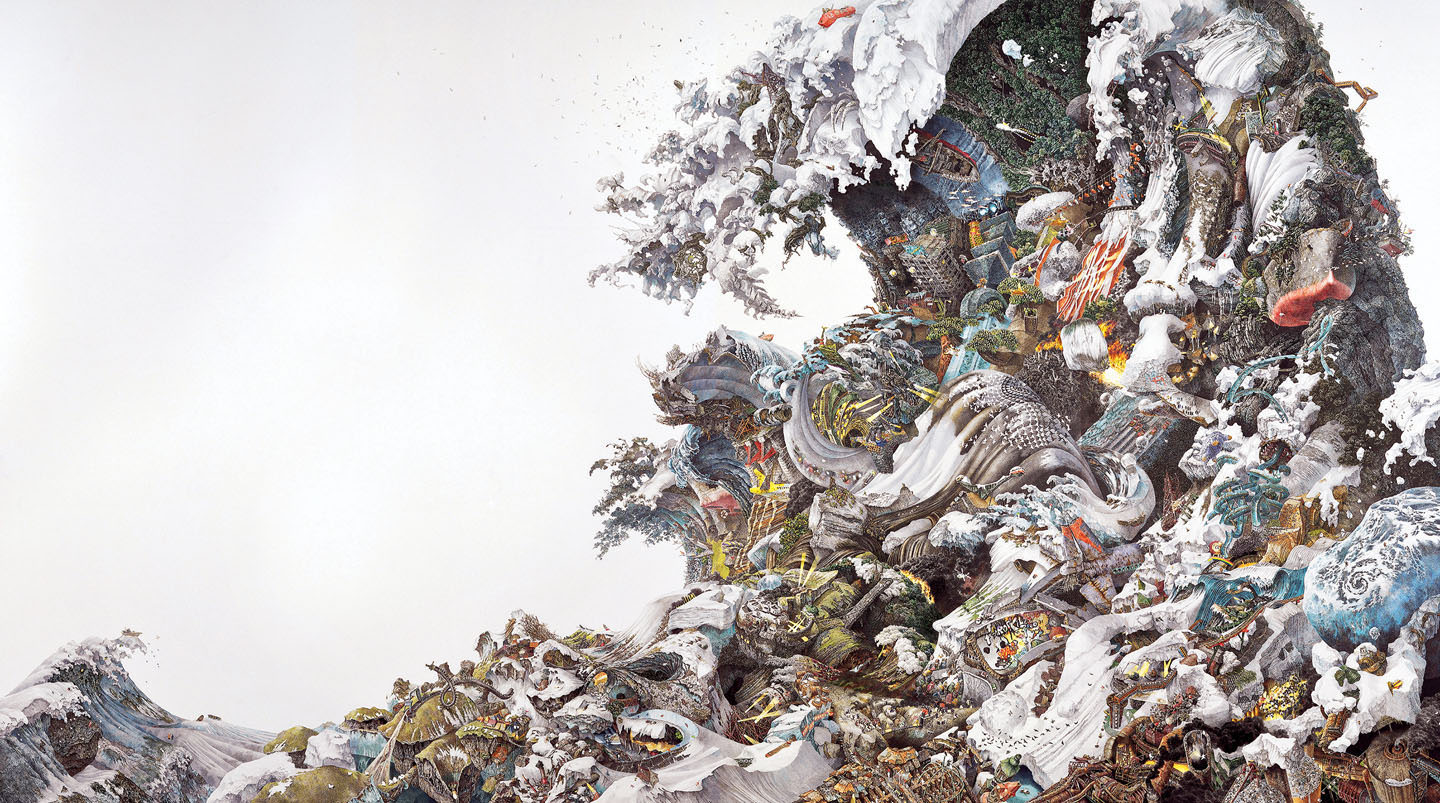
Manabu Ikeda, 予兆 Foretoken, 2008. Pen and acrylic ink on paper, mounted on board, 190 × 340 cm. Collection of Sustainable Investor Co., Ltd. (Kagura Salon). Photo by Yasuhide Kuge.
Take Fortoken (2008): for many, the immediate point of entry will be Hokusai Katsushika’s 19th-century woodblock masterpiece Under the Wave off Kanagawa (The Great Wave). For others, it might be a natural affinity to the work of filmmaker Hayao Miyazaki. In Japan, the work took on an almost prophetic quality following the devastating 2011 Tōhoku earthquake and tsunami, its vision of a world ripped up and frozen in its fragmentation suddenly all too relatable. Indeed, the work was removed from public view out of respect for those affected by the disaster that precipitated the Fukushima nuclear accident. It remained unseen until 2014, when it was included in an exhibition in New York. It would be 2017 before it was presented again in Japan.
Last year Fortoken entered the broader cultural discourse once more when film director Daniel Kwan posted on Twitter that Ikeda’s work had helped when he was struggling with Everything Everywhere All at Once.
“It became a guiding light two years into the writing process when I was feeling overwhelmed by the script, feeling worthless and stupid for trying to tackle something so big,” Kwan wrote. “Manabu’s paintings are pure maximalism,” he continued, “but when you pull back there is still always a core. In this case, it’s a wave. Just a big wave, holding as much as it can. For our script, that core was a family. It’s just a family, holding as much as it can. And wow look at all it holds.”
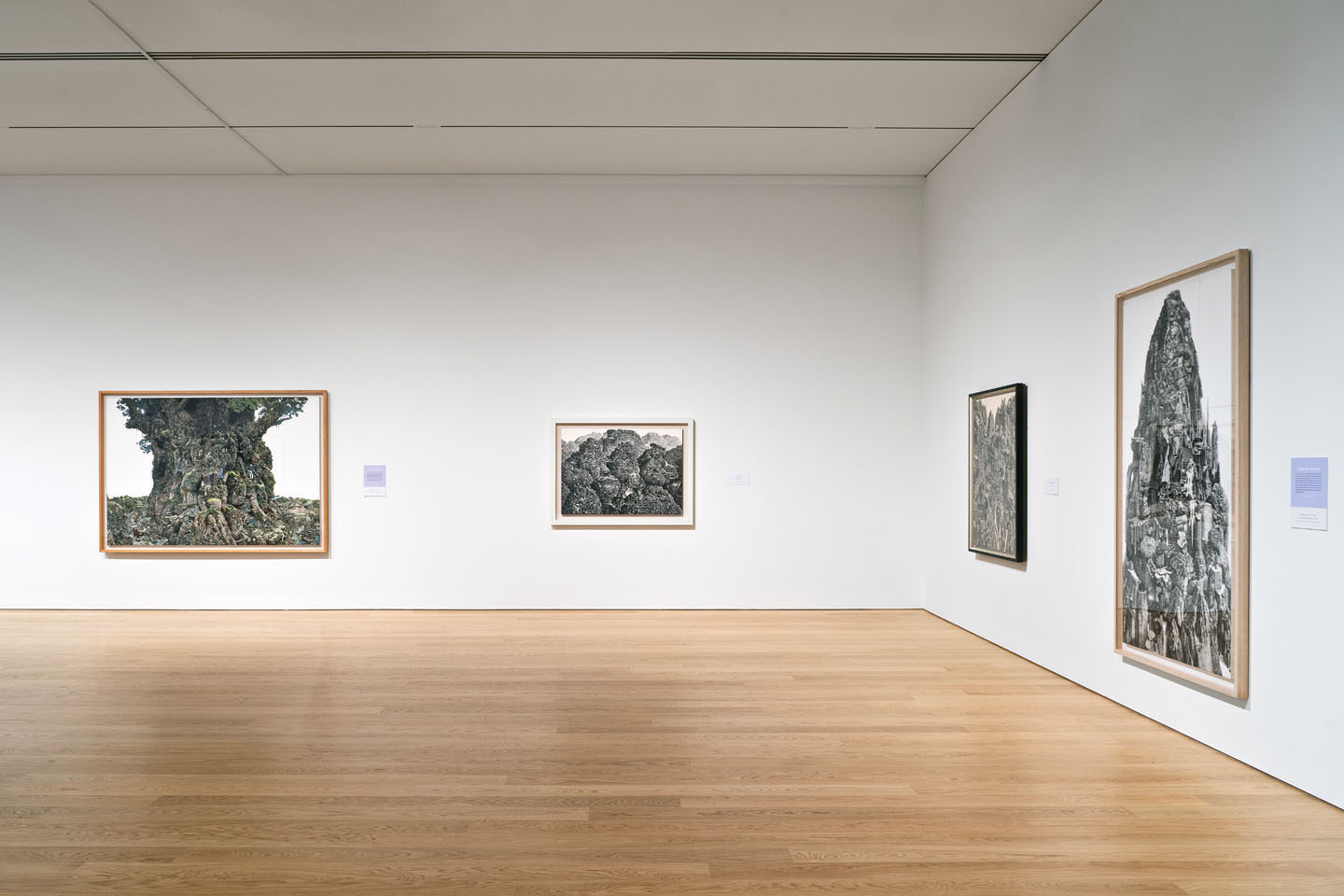
Installation view of Manabu Ikeda: Flowers from the Wreckage. Photo by Michael Levin.
In 2011, Ikeda was living in North Vancouver, thanks to a year-long overseas study grant from the Japanese government. He could have chosen any country but picked Canada because of his passion for the outdoors—he enjoys fishing, climbing, and skiing.
“My theme is humans in nature,” he explains. “Vancouver has lots of nature near the city, and I take a lot of inspiration from nature. In Japan everything is very small”—he smiles and widens his arms—“but in Canada, it is huge. It is very different, and I got a shock. I was able to see the mountains every day, and I am especially interested in the clouds going up or down the mountain.”
The colours of sea and sky here, he says, are very different.
“One of the reasons is that the air is clearer than in Tokyo,” he says. “In Tokyo, everything is grey. I got used to it, and I would draw grey scenery. But in Vancouver, it’s very clear, and everything is brighter.”
He had been thinking about returning to Japan when the earthquake struck. He had recently become a father, and moving back became more complicated as his wife’s parents lived close to Fukushima. The risk was too much, and they stayed in Vancouver, before Ikeda accepted the position of artist-in-residence at Chazen Museum of Art in Madison, Wisconsin, in 2013. He stayed on in the city once his residency was over, and his family has since been bolstered by three more children.
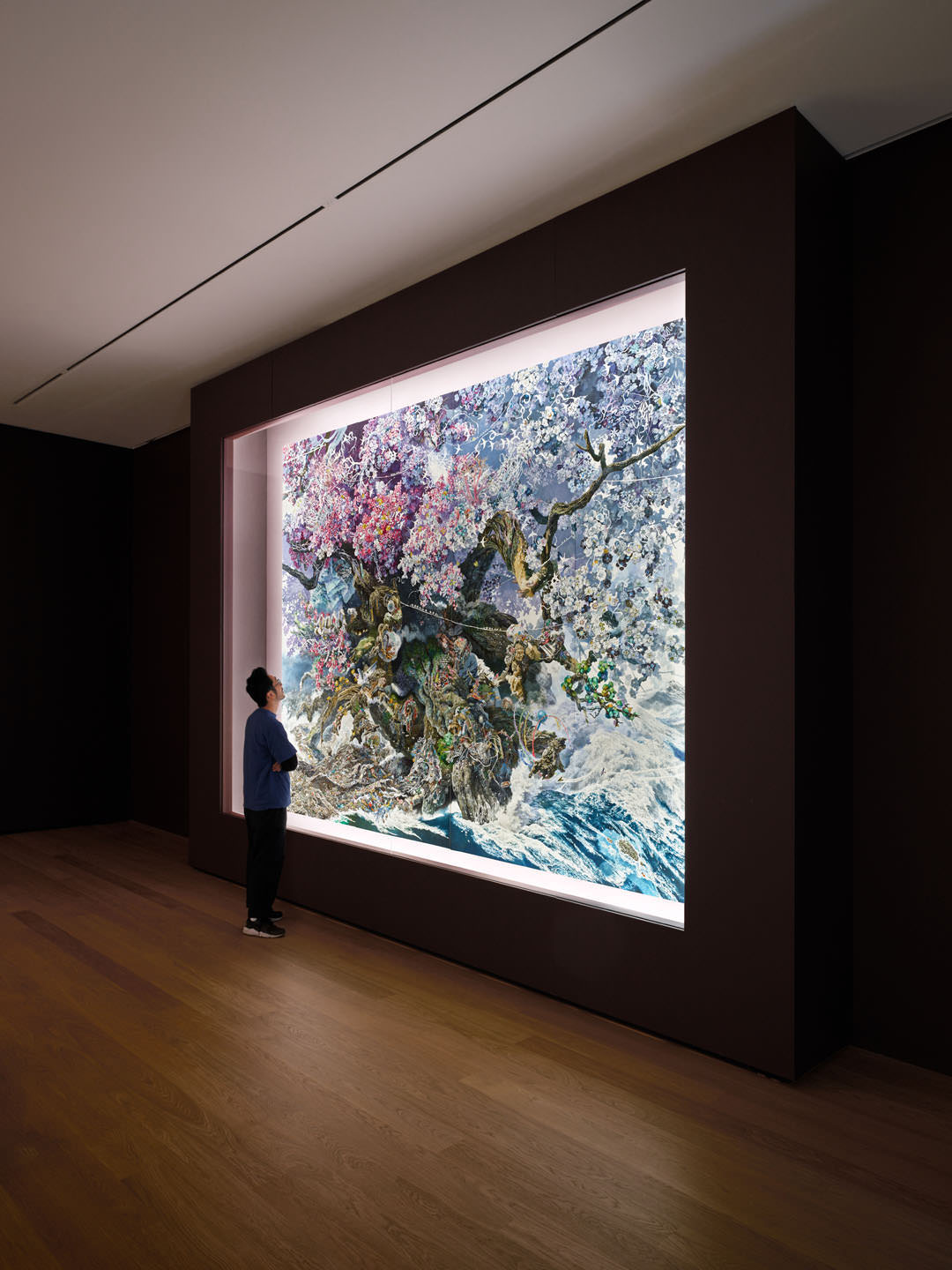
Manabu Ikeda in front of 誕生 Rebirth, 2013–2016. Pen, acrylic ink, and transparent watercolour on paper, mounted on board, 300 × 400 cm. Collection of Saga Prefectural Art Museum, Saga, Japan. Digital Archive by Toppan Printing Co., Ltd.
“No mountains, no ocean.” He sighs. “I miss the mountains every day. But Madison is very peaceful and slow, and the people are more relaxed. My kids go to school there—I don’t have any reason to move.”
He grew up on Kyushu, the southernmost of Japan’s main islands, known for its hot springs, volcanoes, and the creation of tonkotsu ramen. His home city of Saga, considered the birthplace of Japanese porcelain, is 66 kilometres from Nagasaki as the crow flies.
He tells me that although his immediate family was not artistic, there were artists—traditional and modern—among his relatives. Twice a year, at holiday gatherings, the extended family would celebrate, and Ikeda would show his drawings of animals and insects and be given advice. He studied art in Tokyo, learning new mediums and techniques, none of which, he says, felt quite right. In his fourth year, he drew a highly detailed drawing of a mountain, and his teacher suggested trying more of that but on a bigger scale. Suddenly, everything clicked: he didn’t have to think about techniques or materials; all he needed was a pen and pencil.
“Drawing is very much me,” he says. “It’s very simple. I don’t have to wait for paint to dry.”
A colossal display of riotous and poignant imagination, Rebirth is a remarkable achievement.
Before he moved to Wisconsin, Ikeda travelled back to Japan to look at the aftermath of the earthquake first-hand. Until then, he hadn’t felt able to address the disaster in his art. The monumental Rebirth would be his response, taking three years to complete. A colossal display of riotous and poignant imagination, Rebirth is a remarkable achievement, more so when you consider how Ikeda works.
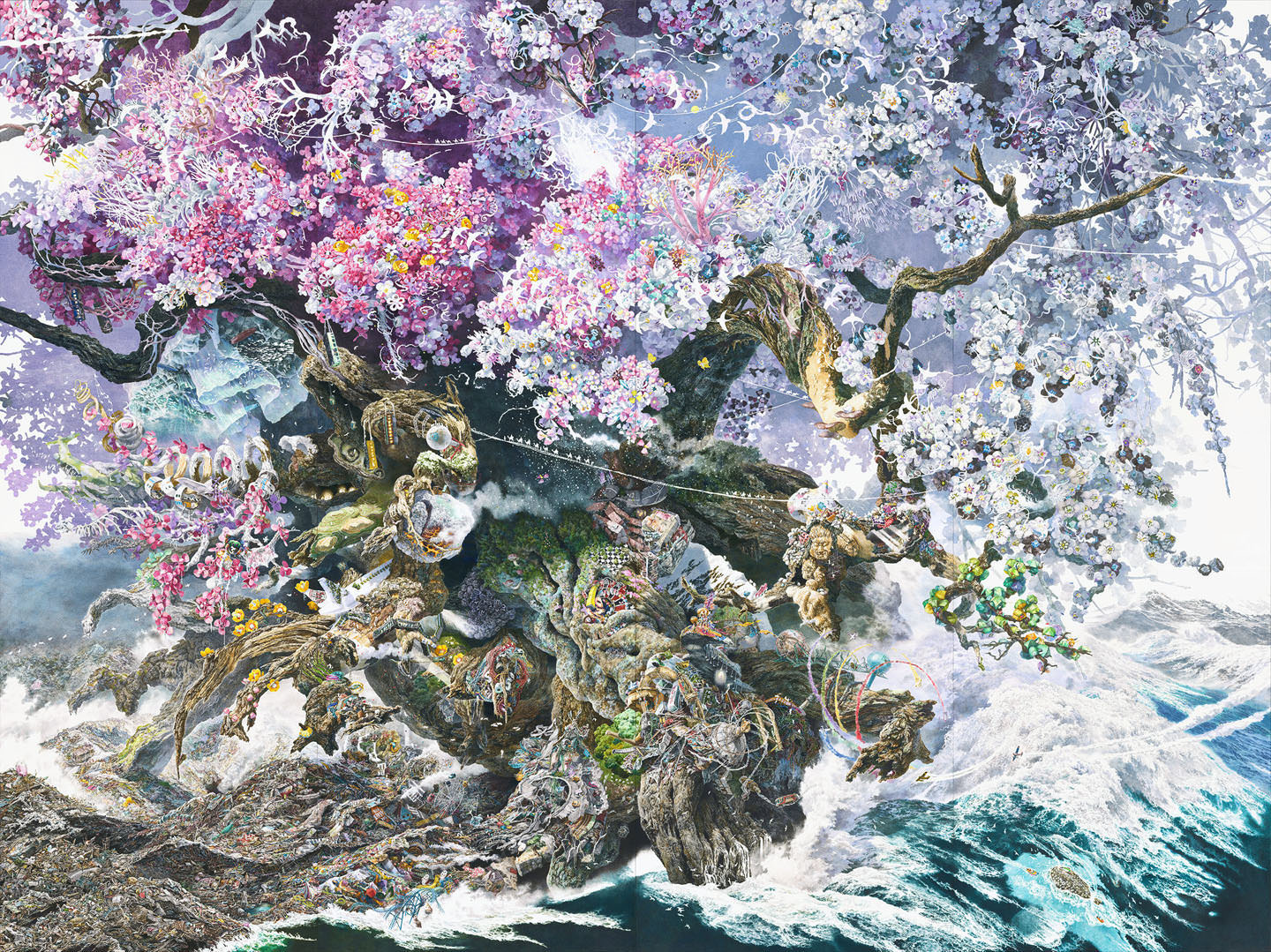
Manabu Ikeda, 誕生 Rebirth, 2013–2016. Pen, acrylic ink, and transparent watercolour on paper, mounted on board, 300 × 400 cm. Collection of Saga Prefectural Art Museum, Saga, Japan. Digital Archive by Toppan Printing Co., Ltd.
“I looked at the blank canvas in front of me, which measured three metres high and four metres wide,” he recalls in the exhibition catalogue. “Filling this with extra-fine lines alone struck me as a preposterous idea. I started by drawing some crushed cars and debris in one small corner. Then trying to imagine what it would be like to actually set foot in a disaster-stricken area, I carefully drew a mountain of rubble. I did this both to etch in my own mind the reality of the disaster, which a part of me had yet to fully accept, and to prepare myself for the long journey ahead.”
The journey was not an easy one: Ikeda dislocated his right shoulder skiing—his drawing arm was out of commission. There was no time to wait for it to heal: there was a deadline for the piece. And though three years seems a long time, the way Ikeda works—drawing consistently for up to eight hours each day—he could not afford to lose any days, let alone weeks or months. His solution? To train his left hand to draw. It was painfully slow going, but now, he says, he can use either hand interchangeably. If you know where to look in Rebirth, you will find a tiny figure, hunched up on a tree branch, holding its injured arm.
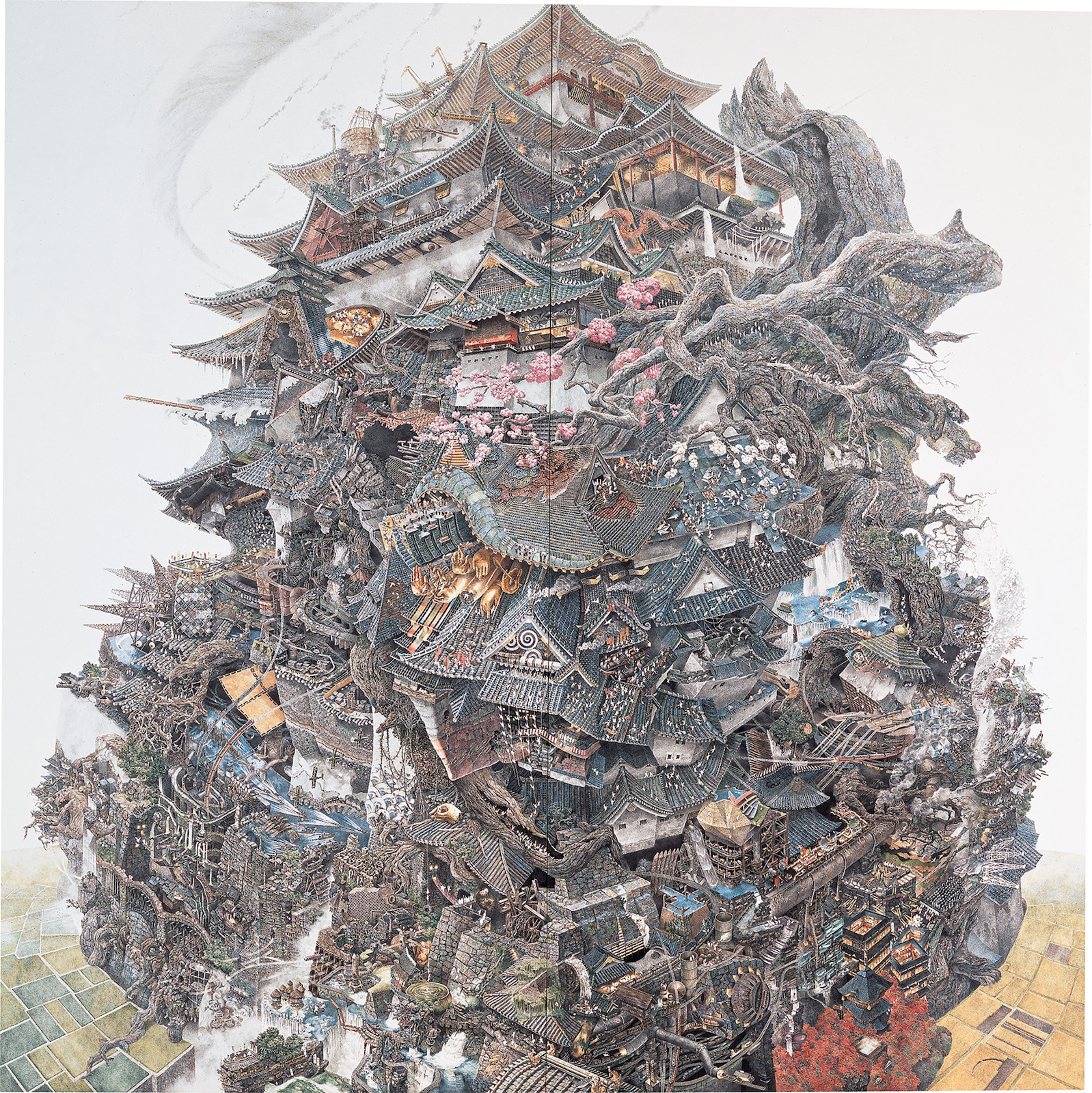
Manabu Ikeda, 興亡史 History of Rise and Fall, 2006. Pen and acrylic ink on paper, mounted on board, 200 × 200 cm. Takahashi Ryutaro Collection. Photo by Kei Miyajima.
Rebirth depicts a regeneration: from a few feet away, the mighty cherry tree appears to be blooming, full of hope and possibilities. Close up, and there is a world of trouble brewing: flowers are the shape of the nuclear sign; others are made of tents or propellers or human hands. Caravans of refugees search for safe havens away from the broken detritus of modern life. There is hope, but it comes with a clear caveat: nature may have the power to regenerate, but life will never look the same.
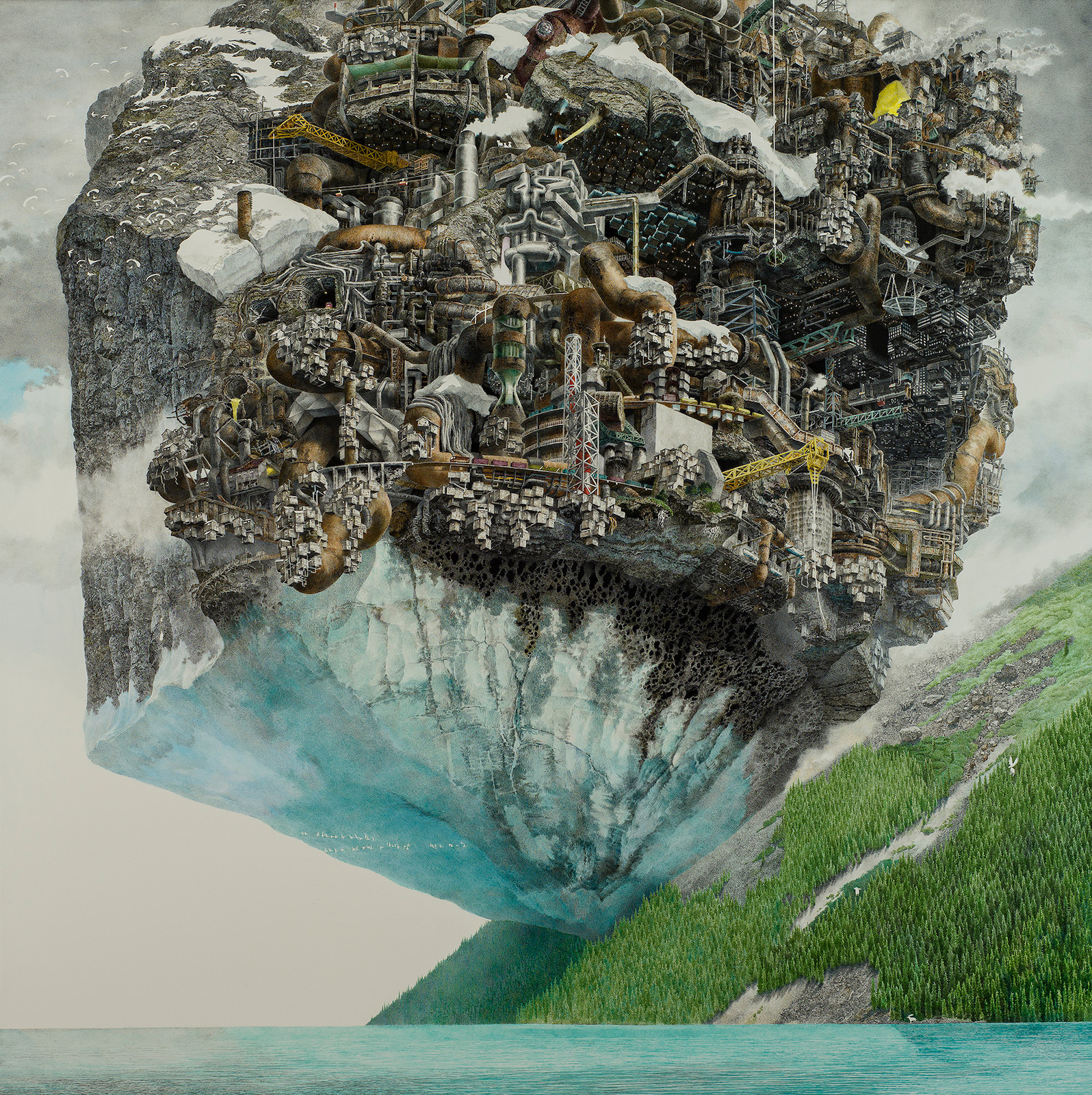
Manabu Ikeda, Meltdown, 2013. Pen and acrylic ink on paper, mounted on board, 122 × 122 cm. Chazen Museum of Art, University of Wisconsin–Madison. Colonel Rex W. and Maxine Schuster Radsch Endowment Fund purchase, 2013.24.
Many visitors to the museum have been moved to tears by Ikeda’s work. There is so much to interrogate in these drawings, the viewer is drawn in, story by story, motif by motif. And somehow, despite (or perhaps because of) the almost impossible task of taking it all in, the artist’s preoccupation with nature and its interactions with human life, the cumulative effect is a wave of emotion. For this life, and this land. For everything, everywhere, all at once.
All photos courtesy of the Audain Art Museum. Read more from our Autumn 2023 issue.

